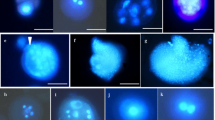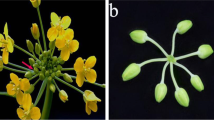Abstract
The influence of different factors on microspore embryogenesis in Chinese cabbage (B. rapa ssp. chinensis) was studied. A genotype dependence for embryo formation was observed. The majority of embryos and plants were obtained from microspores isolated from flower buds (2–2.9 mm in length) and cultured in the NLN liquid medium with 13% sucrose (w/v) supplemented with 24-epibrassinolide and 1% activated charcoal. Embryos cultured on the 1/2 Murashige-Skoog culture medium with 2% sucrose (w/v), 0.1 mg/L benzylaminopurine, and 3 g/L Phytagel stimulated the formation of secondary embryos that resulted in development of large number of doubled haploid plants.
Similar content being viewed by others
References
Alexander, M.P., Differential staining of aborted and non-aborted pollen, Stain Technol., 1969, vol. 44, no. 3, pp. 117–122.
Baillie, A.M.R., Epp, D.J., Hutcheson, D., and Keller, W.A., In vitro culture of isolated microspores and regeneration of plants in Brassica campestris, Plant Cell Rep., 1992, vol. 11, pp. 234–237.
Brosa, C., Biological effects of brassinosteroids, Crit. Rev. Biochem. Mol. Biol., 1999, vol. 34, pp. 339–358.
Burnett, L., Yarrow, S., and Huang, B., Embryogenesis and plant regeneration from isolated microspores of Brassica rapa L. ssp. oleifera, Plant Cell Rep., 1992, vol. 11, pp. 215–218.
Cao, M.Q., Li, Y., Liu, F., and Dore, C., Embryogenesis and plant regeneration of pakchoi (Brassica rapa L. ssp. chinensis) via in vitro isolated microspore culture, Plant Cell Rep., 1994, vol. 13, pp. 447–450.
Cegielska-Taras, T., Tykarska, T., Szala, T., Kuras, M., and Krzymanski, J., Direct plant development from microspore-derived embryos of winter oilseed rape Brassica napus L. ssp. oleifera (DC.) Metzger, Euphytica, 2002, vol. 124, pp. 341–347.
Dias, J.S., Effect of activated charcoal on Brassica oleracea microspore culture embryogenesis, Euphytica, 1999, vol. 108, pp. 65–69.
Ferrie, A.M.R., Epp, D.J., and Keller, W.A., Evaluation of Brassica rapa L. genotypes for microspore culture response and identification of a highly embryogenic line, Plant Cell Rep., 1995, vol. 14, pp. 580–584.
Ferrie, A.M.R., Taylor, D.C., Mac Kenzie, S.L., and Keller, W.A., Microspore embryogenesis of high sn-2 erucic acid in Brassica oleracea germplasm, Plant Cell Tissue Organ Cult., 1999, vol. 57, pp. 79–84.
Ferrie, A.M.R., Dirpaul, J., Krishna, P., Krochko, J., and Keller, W.A., Effects of brassinosteroids on microspore embryogenesis in Brassica species, In vitro Cell. Dev. Biol. Plant, 2005, vol. 41, pp. 742–745.
Friml, J., Vieten, A., Sauer, M., Weijers, D., Schwarz, H., Hamann, T., Offringa, R., and Jurgens, G., Efflux-dependent auxin gradients establish the apical-basal axis of Arabidopsis, Nature, 2003, vol. 426, pp. 147–153.
Gamborg, O.L., Miller, R.A., and Ojima, K., Nutrients requirements of suspension cultures of soybean root cells, Exp. Cell Res., 1968, vol. 50, pp. 151–158.
Gomez, K. and Gomez, A., Statistical Procedures for Agriculture Research, New York: John Willey and Sons: IRRI Publ., 1984.
Grove, M.D., Spencer, G.F., Rowedder, W.K., Mandava, N., Worley, J.F., Warthen, J.D., Jr., Steffens, G.L., Flippen-Anderson, J.L., and Cook, J.K., Jr., Brassinolide, a plant growth promoting steroid isolated from Brassica napus pollen, Nature, 1979, vol. 281, pp. 216–217.
Guo, Y.D. and Pulli, S., High-frequency embryogenesis in Brassica campestris microspore culture, Plant Cell Tiss. Org. Cult., 1996, vol. 46, pp. 219–225.
Huang, B., Bird, S., Kemble, R., Miki, B., and Keller, W., Plant regeneration from microspore-derived embryos of Brassica napus: effect of embryo age, culture temperature, osmotic pressure, and abscisic acid, In vitro Cell Dev. Biol. Plant, 1991, vol. 27, pp. 28–31.
Ilic-Grubor, K., Attree, S.M., and Fowke, L.C., Comparative morphological study of zygotic and microspore-derived embryos of Brassica napus L. as revealed by scanning electron microscopy, Ann. Bot., 1998, vol. 82, pp. 157–165.
Keller, W.A. and Armstrong, K.C., Production of haploids via anther culture in Brassica oleracea var. italica broccoli, Plant Breed., 1983, vol. 32, pp. 151–159.
Kott, L. and Beversdorf, W.D., Enhanced plant regeneration from microspore-derived embryos of Brassica napus by chilling, partial dessication and age selection, Plant Cell Tiss. Org. Cult., 1990, vol. 23, pp. 187–192.
Kott, L.S., Application of double haploid technology in breeding of oilseed Brassica napus, AgBiotech. News Inf., 1998, vol. 10, no. 3, pp. 69N–74N.
Kuginuki, Y., Nakamura, K., Hida, K.I., and Yosikawa, H., Varietal differences in embryogenic and regenerative ability in microspore culture of Chinese cabbage (Brassica rapa L. ssp. pekinensis), Breed Sci., 1997, vol. 47, pp. 341–346.
Lichter, R., Induction of haploid plants from isolated pollen of Brassica napus, Z. Pflanzenphysiol., 1982, vol. 105, pp. 427–434.
Lichter, R., Efficient yield of embryoids by culture of isolated microspores of different Brassicaceae species, Plant Breed., 1989, vol. 103, pp. 119–123.
Lionneton, E., Beuret, W., Delaitre, C., and Rancillac, M., Improved microspore culture and doubled-haploid plant regeneration in the brown condiment mustard (Brassica juncea), Plant Cell Rep., 2001, vol. 20, pp. 126–130.
Lo, K.H. and Pauls, K.P., Plant growth environment effects on rapeseed microscope development and culture, Plant Physiol., 1992, vol. 99, pp. 468–472.
Lu, Z., Hunga, M., Ge, D.P., Yang, Y.H., Cai, X.N., Qin, P., and She, J.M., Effect of brassinolide on callus growth and regeneration in Spartina patens (Poaceae), Plant Cell Tiss. Org. Cult., 2003, vol. 73, pp. 87–89.
Margale, E. and Chevre, A.M., Factors effecting embryo production from microspore culture of Brassica nigra (Koch.), Cruciferae Newsl., 1991, vol. 14, no. 15, pp. 100–101.
Monakhos, S.G., Iguen, M.L., Bezbozhnaya, A.V., and Monakhos, G.F., Relationship of ploidy with the number of chloroplasts in guard cells of stomata in diploid and amphiploid Brassica species, S.-Kh. Biol., 2014, no. 5, pp. 44–54.
Moore, T.C., Biochemistry and Physiology of Plant Hormones, New York: Springer Verlag, 1989, pp. 255–266.
Murashige, T. and Skoog, F., A revised medium for rapid growth and bio assays with tobacco tissue cultures, Physiol. Plant., 1962, vol. 15, pp. 473–497.
Nagl, W., Translocation of putrescine in the ovule, suspensor and embryo of Phaseolus coccineus, J. Plant Physiol., 1990, vol. 136, pp. 587–591.
Nakajima, N., Shida, A., and Toyama, S., Effects of brassi-nosteroid on cell division and colony formation of Chinese cabbage mesophyll protoplasts, Jpn J. Crop. Sci., 1996, vol. 65, pp. 114–118.
Ockendon, D.J., The ploidy of plants obtained from anther culture of cauliflowers (Brassica oleracea var. botrytis), Ann. Appl. Biol., 1988, vol. 113, pp. 319–325.
Palmer, C.E. and Keller, W.A., Haploidy, in Biology of Brassica coenospecices, Gomez-Campo, C., Ed., Amsterdam: Elsevier, 1999, pp. 247–286.
Pechan, P.M. and Keller, W.A., Identification of potentially embryogenic microspores in Brassica napus, Physiol. Plant., 1988, vol. 74, pp. 377–384.
Peng, S., Takahata, Y., Hara, M., Shono, H., and Ito, M., Effects of the matric potential of culture medium on plant regeneration of embryo derived from microspore of Brassica napus, J. Shita, 1994, vol. 5, no. 6, pp. 8–14.
Prem, D., Gupta, K., and Agnihotri, A., Effect of various exogenous and endogenous factors on microspore embryogenesis in Indian mustard (Brassica juncea [L.] Czern & Coss), In vitro Cell Dev. Biol. Plant., 2005, vol. 41, pp. 266–273.
Prem, D., Gupta, K., Sarkar, G., and Agnihotri, A., Activated charcoal induced high frequency microspore embryogenesis and efficient doubled haploid production in Brassica juncea, Plant Cell Tiss. Org. Cult., 2008, vol. 93, pp. 269–282.
Sasaki, H., Brassinolide promotes adventitious shoot regeneration from cauliflower hypocotyl segments, Plant Cell Tiss. Org. Cult., 2002, vol. 71, pp. 111–116.
Sato, T., Nishio, T., and Hirai, M., Plant regeneration from isolated microspore cultures of Chinese cabbage (Brassica campestris spp. pekinensis), Plant Cell Rep., 1989, vol. 8, pp. 486–488.
Supena, E.D.J., Innovations in microspore embryogenesis in Indonesian hot pepper (Capsicum annuum L.) and Brassica napus L., Ph.D. Thesis, Wageningen, the Netherlands: Wageningen Univ., 2004.
Takahashi, Y., Yokoi, S., and Takahata, Y., Effects of genotypes and culture conditions on microspore embryogenesis and plant regeneration in several subspecies of Brassica rapa L., Plant Biotechnol., 2012, vol. 6, pp. 297–304.
Takahata, Y. and Keller, W.A., High frequency embryogenesis and plant regeneration in isolated microspore culture of Brassica oleracea L., Plant Sci., 1991, vol. 74, pp. 235–242.
Telmer, C.A., Simmonds, D.H., and Newcomb, W., Determination of developmental stage to obtain high frequencies of embryogenic microspores in Brassica napus, Physiol. Plant., 1992, vol. 84, pp. 417–424.
Wakui, K., Takahata, Y., and Kaizuma, N., Effect of abscisic acid and high osmoticum concentration on the induction of desiccation tolerance in microspore-derived embryos of Chinese cabbage (Brassica campestris L.), Breed Sci., 1994, vol. 44, pp. 29–34.
Wilen, R.W., Sacco, M., Gusta, L.V., and Krishna, P., Effects of 24-epibrassinolide on freezing and thermotolerance of bromegrass (Bromus inermis) cell cultures, Physiol. Plant., 1995, vol. 95, pp. 195–202.
Wong, R.S.C., Zee, S.Y., and Swanson, E.B., Isolated microspore culture of Chinese flowering cabbage (Brassica campestris ssp. para chinensis), Plant Cell Rep., 1996, vol. 15, pp. 396–400.
Yeung, E.C., Embryogeny of Phaseolus—role of the suspensor, Z. Pflanzenphysiol., 1980, vol. 96, pp. 17–28.
Yeung, E.C. and Meinke, D.W., Embryogenesis in angiosperms: development of the suspensor, Plant Cell, 1993, vol. 5, pp. 1371–1381.
Zhang, G.Q., Zhang, D.Q., Tang, G.X., He, Y., and Zhou, W.J., Plant development from microspore-derived embryos in oilseed rape as affected by chilling, desiccation and cotyledon excision, Biol. Plant., 2006, vol. 50, pp. 180–186.
Author information
Authors and Affiliations
Corresponding author
Additional information
Original Russian Text © D.V. Shumilina, N.A. Shmykova, L.L. Bondareva, T.P. Suprunova, 2015, published in Izvestiya Akademii Nauk, Seriya Biologicheskaya, 2015, No. 4, pp. 368–375.
Rights and permissions
About this article
Cite this article
Shumilina, D.V., Shmykova, N.A., Bondareva, L.L. et al. Effect of genotype and medium culture content on microspore-derived embryo formation in Chinese cabbage (Brassica rapa ssp. chinensis) cv. Lastochka. Biol Bull Russ Acad Sci 42, 302–309 (2015). https://doi.org/10.1134/S1062359015040135
Received:
Published:
Issue Date:
DOI: https://doi.org/10.1134/S1062359015040135




